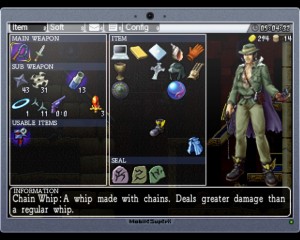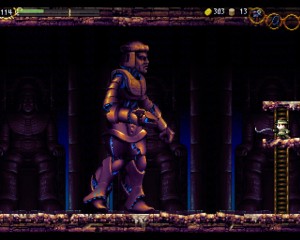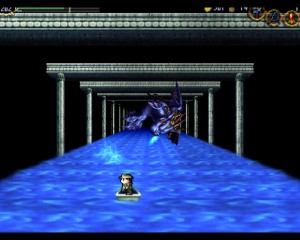Recently I’ve been getting acquainted with the game: La Mulana – A 2d open world platformer adventure title. Or in other words: A metroidvania on steroids.
Having spent a week playing La-Mulana, I don’t think I’m going to be solving its mysteries any time soon… unless the solution involves uninstalling the game.
Treasure Hunting:
The story of La-Mulana is that you are on a quest to unravel the mystery of a mysterious temple that your father discovered.
As you can see from the screenshots, La-Mulana is definitely old school in the graphics department. But the game does pull out some nifty tricks for the boss fights.
The gameplay is the heart of La-Mulana’s excitement and frustration. The design is open world, allowing you to explore almost everywhere from the start. The temple is split into different sections, each with their own enemies, puzzles and treasures to be found.
Treasures are very important in La-Mulana, as each one will grant you some kind of upgrade: new weapons, equipment or simply a health boost. Opening up treasure chests requires you to solve a puzzle which can come in many forms. The game throws clues at you through tablets to try and guide you to the general conclusion, but expect to have more questions than answers.
If the puzzles weren’t challenging enough, La-Mulana features plenty of tricky platforming segments.
La-Mulana‘s jumping system was largely committed base: meaning that once you performed a jump, you were committed to the trajectory set out.
You can make slight alterations in mid air, but nowhere to the degree of modern 2d platformers.
Each area of the game also had a boss fight that required you to solve a number of puzzles in the area to unlock. These creatures were always huge in stature, requiring careful movement and attacking to take them out. The careful movement part however was more trouble than it was worth, which I’ll be coming back to in a minute.
What La-Mulana gets right was really delivering on the concept of taking a metroidvania type design to the nth degree. For people who want an action adventure title that lets you go off the chain and do what you want, La-Mulana is perfect for you. However, La-Mulana‘s design was frustratingly old school and lacks the polish to really elevate the title.
A Deadly Game of Hide and Seek:
The problems with La-Mulana’s open world design were not readily apparent from the get-go. And for the first few hours, it’s easy to declare La-Mulana an amazing game and leave it at that. But the further you get in, the challenge of the game gives way to frustration.
Solutions to puzzles were not always near the puzzle, or even in the same area requiring you to back track through areas to find what you need. Even solving a puzzle was not always readily apparent, as I had cases where I did something in one room that solved a puzzle in another room without any clue that it was the solution.
Later puzzles may require you to do something in a completely different section or find an item that the game may only give an esoteric clue about. For instance in the first section, I was moving through the area activating switches and without knowing it, I solved the “grand puzzle” that unlocked the boss fight.

Items are vital for making any form of progress in the game. Too bad that figuring out said progression is a frustrating ordeal.
To make things worse, the game falls back on the always frustrating: hidden walls and secret rooms for progression and hints.
You can find clues to secret rooms as you get further into the game, but you’ll be dealing with them a lot sooner than that.
The game tries to be clever with forcing you to explore for solutions, but there is a difference between being clever and just being frustrating. There are many cases where the player may just wander around a section not knowing if they missed the solution, or if they need to come back later.
The tablets that you can find swing between clues for a puzzle and flavor text, but it can be hard to figure out the signal from the noise.
When I finally reached the point that I was done trying to piece the game together and starting to watch a walk-through for hints, I never thought to myself ” I can’t believe I missed that” but instead “that was the fricken solution the entire time?!” There were several situations where the trigger for the next puzzle had no relation to the actual puzzle itself.
Another annoyance were “holy sections” where a blue eye will shock the player if they perform an incorrect action. The problem was that said action was different for every room. One time you may get shocked for incorrectly hitting a switch, another time it will because you swung your weapon in mid air. Dying because of an arbitrary inconsistent mistake is just poor design.
La-Mulana from some of my friends, described it as a 2D take on Dark Souls, and I can see the comparison, but the big difference is how they handle progression. In Dark Souls, while the entire game was open from the start, the only limiting factor was the player’s skill and character design. But in La-Mulana, the open nature of the game becomes more and more limited by the esoteric path the game wants you to carve through it.
Playing Dark Souls, the design of each area was insular: in which once you made it to a new area you could explore to your heart’s content with rare exception.
But imagine if you could only explore each area a little bit before having to go somewhere else and keep flipping back and forth between areas. Granted the metroidvana style was built on that concept, but with other games they at least give you a clear indication of what is and what isn’t possible at that point.

The short attack range of your primary weapons makes it very difficult to fight the many enemies without getting hit yourself.
La-Mulana’s puzzles and clue system try too hard to be complex, and instead leave the player guessing as to what to do next.
It reminds me almost of older adventure games where once you find a new item, you then go back to every locked door or puzzle and use said item to see if it unlocks the next path.
Except here, you actually have to fight your way back to each spot first.
Speaking about fighting, La-Mulana‘s combat system leaves a lot to be desired. The problem was that while the player was stuck using conventional controls and movement, the enemies are not.
Your attack range was very limited: just barely the height of the character. When you combine limited range with committed movements it leads to frustration. Most of the time, you’re going to run into the enemy taking damage when trying to hit them. This occurs even more when you have to jump at enemies to hit them.
In the end, La-Mulana comes close to being an amazing game, but skids right off the edge into a frustrating and poorly designed experience. Creating a game that challenges without frustrating the player is an art form, that many try but few succeed.



